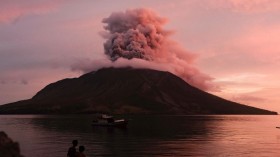Using ivory DNA, scientists have identified two major elephant poaching hotspots, a discovery that may help police trace the origin of an illegal trade that is decimating African elephant populations.
In the journal Science, researchers from the University of Washington (UW) showed that over the past decade, ivory has largely come from just two areas in Africa - one each for the forest and savanna elephants.
"Africa is a huge continent, and poaching is occurring everywhere. When you look at it that way it seems like a daunting task to tackle this problem," lead author and biologist Samual Wasser said in a statement. "But when you look at large ivory seizures, which represent 70 percent of illegal ivory by weight, you get a different picture."
About 50,000 African elephants are now being killed each year from a population of fewer than 500,000 animals. Poaching is driving these iconic animals toward extinction, but knowing where elephants are poached the most could help combat ivory trafficking at its source.
"Understanding that vast amounts of this major transnational trade is focused on two primary areas makes it possible to focus law enforcement on those areas and eliminate the largest amount of illegal killing," Wasser said.
To pinpoint these locations, Wasser and his colleagues used DNA from tons of seized ivory samples associated with large-scale trafficking.
The UW group used its method to analyze 28 large ivory seizures, each more than half a ton, made between 1996 and 2014. The samples include 61 percent of all large seizures made worldwide between 2012 and 2014.
According to the analysis, more than 85 percent of the forest elephant ivory seized between 2006 and 2014 was traced to the central African Tridom - a protected ecosystem that spans northeastern Gabon, northwestern Republic of Congo and southeastern Cameroon.
For the savanna elephant, more than 85 percent of its seized ivory was traced to East Africa, mainly from the Selous Game Reserve in southeastern Tanzania and the Niassa Reserve in adjacent northern Mozambique.
The results also show that since 2006, poaching hotspots have started to shift. From 1996-2005, most of the forest elephant ivory Wasser's team analyzed came from the eastern Democratic Republic of Congo. However, none of the forest elephant samples after 2005 came from that area.
Meanwhile, two seizures of savanna elephant ivory, in 2002 and 2007, came from Zambia, but the country was not represented in any of the collected samples after 2007.
Currently, steps are being taken to curb trafficking, such as reducing demand and enacting stricter bans on ivory products. Though, it's debatable whether or not these tactics are working. China, for example, the world's largest importer of illegal ivory, seems to be continuing the trade despite claims to stop it. Officials accompanying President Xi Jinping during a trip to Tanzania even went on an ivory buying spree back in November.
Wasser, too, agrees that despite recent efforts, the process of stamping out the illegal ivory trade is happening too slowly.
"When you're losing a tenth of the population a year, you have to do something more urgent - nail down where the major killing is happening and stop it at the source," Wasser said. "Hopefully our results will force the primary source countries to accept more responsibility for their part in this illegal trade, encourage the international community to work closely with these countries to contain the poaching, and these actions will choke the criminal networks that enable this transnational organized crime to operate."
For more great nature science stories and general news, please visit our sister site, Headlines and Global News (HNGN).
© 2024 NatureWorldNews.com All rights reserved. Do not reproduce without permission.

![Extreme Heat Wave in Africa’s Sahel Region That Killed 100 People Linked to Climate Change [Study]](https://1471793142.rsc.cdn77.org/data/thumbs/full/70226/280/157/50/40/extreme-heat-wave-in-africa-s-sahel-region-that-killed-100-people-linked-to-climate-change-study.jpg)



